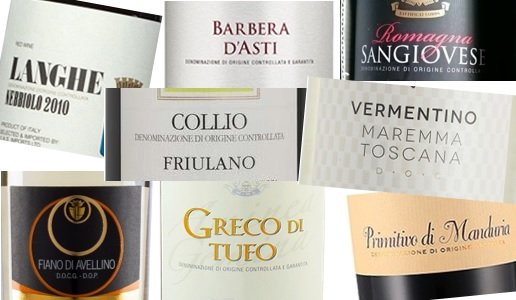According to European Union law, to place the name of a varietal on a wine label it is sufficient that the wine be at least 85% made with that grape. The rest can be composed of varieties permitted by the various production regulations.
Many Italian DOCG, DOC and IGT wines have on their labels the name of the principal varietal used in production and this leads many consumers to believe that these wines are made with only that grape variety. By reading production regulations, however, it is easy to realize that this is hardly ever the case, given that norms almost always allow for a percentage of other varietals that can range from 5 to 15% of the final product.
This is true for all DOC Langhe and Maremma Toscana wines that have the varietal name on the label. The same is true for Greco di Tufo, Fiano di Avellino, Vermentino di Gallura, Verdicchio dei Castelli di Jesi, Barbera d’Asti and Alba. This does not mean that producers necessarily use other grapes, only that it is possible and legal for many wines.
There exist wines, of course, which by regulations are made with a single variety of grape, wines like Brunello di Montalcino, Barolo and Barbaresco. They are not many and are generally the more famous wines and they almost never have the name of the varietal on their label.
In the United States, the percentage of the principal grape named on the label falls to 75% and so, for example, most of the Cabernet Sauvignon from the Napa Valley are blended with other grapes, for the most part Merlot.
I’m sure most of our readers already know all this. And so I wonder whether those engaged in a holy crusade over the concept of single varietal wines realize that, aside from some prestigious DOC and DOCG wines that, in any case, do not name the varietal on the label, preferring to put the name of the origin of the grape (as is the case in Bordeaux, Burgundy and, almost always, Champagne), production regulations allow for some blending, at times significant, in those wines named after the varietal.
The fact is, almost everywhere in the world the great wines are identified by their place of origin – Rioja, Ribera del Duero, Porto, Sancerre, Chambertin, Paulliac – and not certainly the name of the principal varietal used. I still remember the faux pas I made many years ago with Madame Lalou Bize-Leroy, at the time head of Domaine de la Romanée Conti, when in an interview I introduced her as one of the world’s greatest interpreters of Pinot Noir. She told me I was mistaken. She did not make Pinot Noir, which she said was what they made in Oregon and Washington, she made Romanée Conti, La Tasche and Richebourg. True, these were made with Pinot Noir, but there was a big difference.




